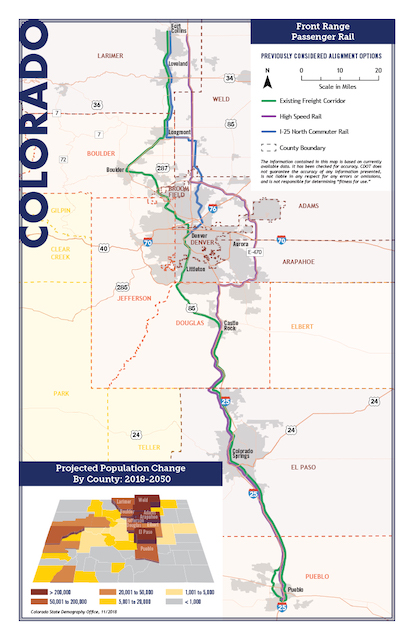The pandemic has made people reluctant to climb aboard any form of mass transportation. But it hasn’t stopped the state of Colorado from planning an idiotic Front Range passenger train that is proposed to connect Fort Collins and Pueblo, with Denver in between. In June, Governor Jared Polis signed a bill creating a taxing district to pay for the train’s inevitable losses. Last week, the Colorado Transportation Commission agreed to spend $1.9 million on a viability study (whose total cost will be twice that).
Although the endpoints are known, the exact route of the proposed rail line through Denver has yet to be determined. Click image for a larger view.
The Denver Post, which was a major cheerleader for Denver’s $4.9 billion FasTracks plan until it became the $7.9 billion FasTracks plan, by which time it was too late, is now a major cheerleader for the Front Range passenger train plan. It claims that an Amtrak train between Chicago and Milwaukee “shows what it could be.” Yes, because Fort Collins (population: 170,000) and Pueblo (population: 112,000) are just like Milwaukee (population: 577,000), and Denver (population: 715,000) is just like Chicago (population: 2.75 million).
In what amounts to a footnote, the Post also mentions the Albuquerque-to-Santa Fe train, which (the paper says) costs the state of New Mexico $24 million a year (in fact, it was $38 million in 2019) and whose ridership has declined each year since 2010, which the paper blames on “long travel times.” Travel times on trains from Fort Collins to Pueblo are likely to be worse because such trains will have to compete with freight trains for space on the rails while the New Mexico passenger train mostly has the rails to itself.
The paper also mentions the Portland-Seattle route, on which the state of Washington lavished $800 million “since 2010 on improvements to reduce travel times, which pose an ongoing challenge.” Which is another way of saying that travel times still haven’t been reduced eleven years, $800 million, and three lives later. The paper doesn’t mention that, even if successful, all that money would have increased train speeds by just 2.7 miles per hour. What a great success story!
Denver’s Regional Transit District (RTD) would also like to see the project funded. RTD’s FasTracks plan called for a rail line to Longmont, but due to cost overruns, it ran out of money for that line. The Front Range train, if funded, would satisfy the desire of Longmont officials to have a train to play with.
The state already subsidizes a bus service in this corridor which carried 171,000 passengers in 2019. Amtrak projects that, if passenger trains began operating, they would attract 200,000 passengers per year. Start-up costs are expected to be between $1.7 billion and $2.8 billion. Can anyone really believe that it would be worth that much money to attract 29,000 more passengers per year?
I can save the state a lot of money and tell them that this boondoggle isn’t viable, but we apparently have different definitions of viable. My definition is, “Is a passenger train the most cost-effective way of meeting transportation goals?” Their definition is, “Can we sell this turkey to the voters of up to 13 counties?” Since FasTracks cost a lot of money and failed to get anyone out of their car (transit’s share of commuting in 2019 being slightly less than it was in 2000), you have to wonder what Colorado officials are smoking to think that another passenger train will make any difference.









Appropriate intercity high-speed roadways can be built for less than comparable rail rights of way. A “High speed bus” is promising concept. So a dedicated highway lane or high occupancy lane could easily accommodate this new vehicle. As new technologies emerge there’s little rail aficionados can do to compete against new emerging technologies. So the bus might not go 200, but could do 100, 120. Maybe even more, since the bus can be powered by the same overhead technology.
”
Travel times on trains from Fort Collins to Pueblo are likely to be worse because such trains will have to compete with freight trains for space on the rails while the New Mexico passenger train mostly has the rails to itself.
”
Sounds like they want to run on the old Colorado & Southern.
I’d imagine there may be some spare capacity with the downtown in shipments of Powder River Basin coal.
Then again, as Metro Transit found out after pissing away $120 million in “planning” their blue line extension, just because BNSF has capacity doesn’t mean they’re gonna play.
It’s a good time to float a Fort Collins – Pueblo train because I-25 is temporarily screwed up with construction between both cities and Denver. Even so, I’ve driven to both cities from Denver averaging 65 miles/hour. I imagine rush hour is terrible though. Both road widening projects will be done in a few years though so the ridiculous rail project has only a short time to get rammed through.
No one will ride it. Why would they? You still need a car to get around Ft. Collins and Pueblo once you arrive by train. It would be cheaper and faster to just drive the whole way.
What is the point of spending money on a “viability study” when you’ve already taken the step of setting up a taxing district to lavish subsidies on this vanity project? Apparently ‘viability’ has a different meaning in their world than it does in mine.